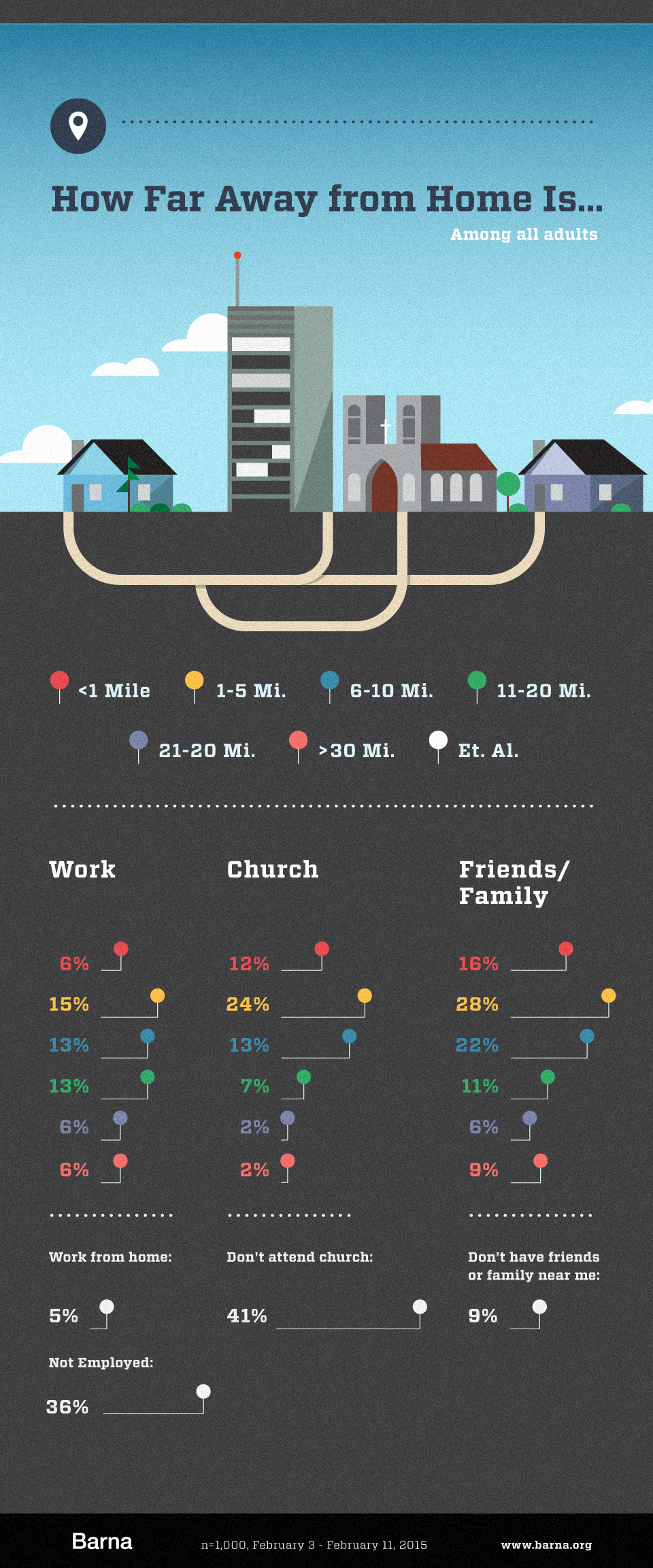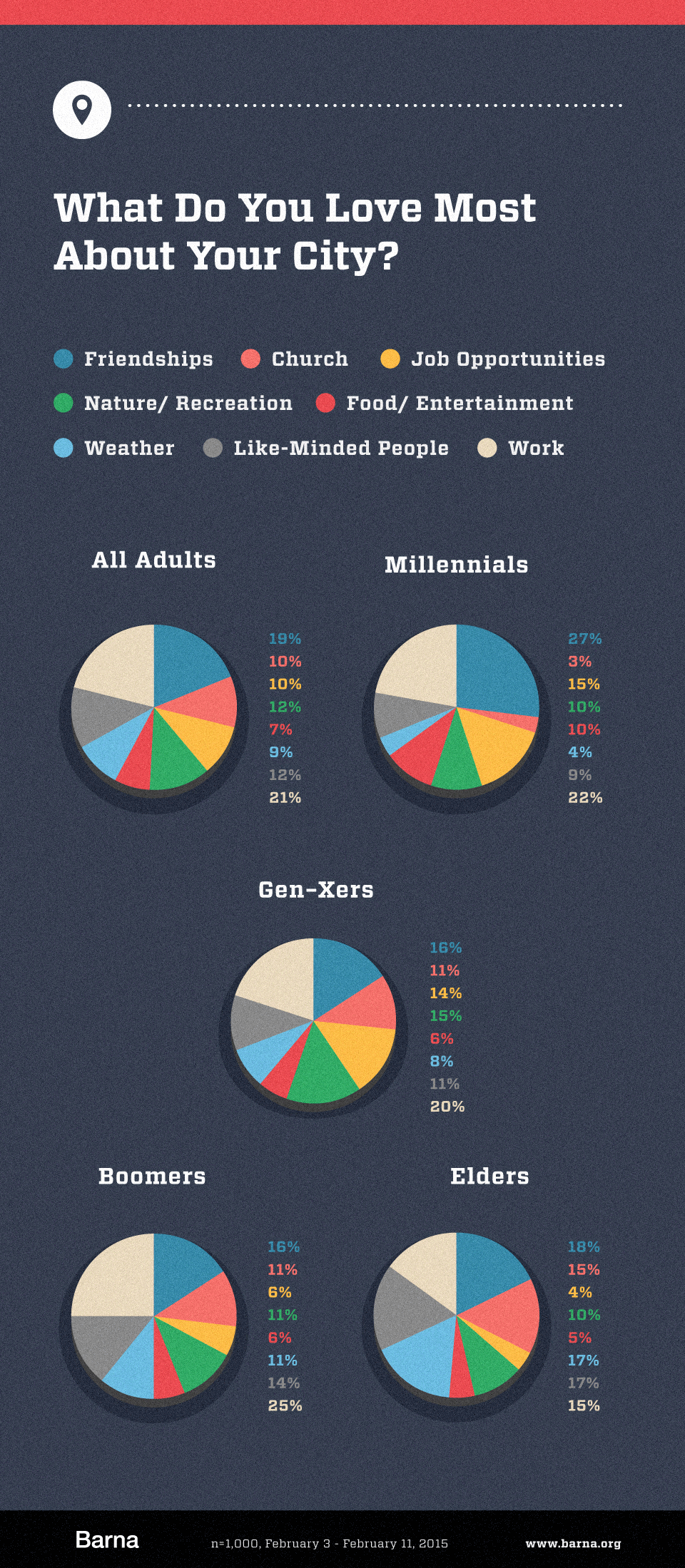Friendships Are the Top Thing People Love Most About Their Cities
“There’s no place like home,” repeats Dorothy as she taps those famous ruby slippers together. The place to which she so desperately longs to return is Kansas, that little corner of the world she calls home. One might imagine the Depression-era dustbowl of Kansas is no match for the wonders of Oz, but it’s the place she feels rooted, attached and secure.
Your Leadership Toolkit
Strengthen your message, train your team and grow your church with cultural insights and practical resources, all in one place.
In literature and in cinema, there is no shortage of heroes’ journeys that end up back where they started. From Odysseus to Bilbo Baggins to Dorothy, wanderlust eventually turns to homesickness and the pull of the familiar overrides the glories of adventure. But what is it about home that’s such a draw? Dorothy’s repeated attempts to return to Kansas are less about the physical place itself and more about the meaning her attachments there bring to her sense of self. What most people seem to long for and grieve while in exile (even if it’s in the Technicolor land of Oz) are the social connections that friends, family and community bring to their sense of belonging.
Barna recently conducted research into this “sense of place,” asking Americans where they live, why they choose to live there and what they love most about the place they call home. We found that although Americans often move for different reasons, the most consistent characteristics that make a place worth staying in are relational.
What other factors are important when it comes to finding a place to call home? What do Americans love most about their neighborhoods and cities? And how do generational factors influence their priorities and choices?
The Daily Commute
The average American spends about 38 hours a year stuck in traffic. That’s the equivalent of honking your horn for a whole week of work. Barna found that for most adults it’s important that their commute be reasonable, with more than half saying they live within 20 miles of their workplace (52%). They don’t want to be too close however; most within that larger group live at least one mile away—only six percent of commuters live within one mile of work, and about five percent of adults overall work from home.
This corresponds with other data in Barna’s study, showing that most Americans make a home in the suburbs (50%). Because jobs tend to be concentrated within business districts in city centers—not in the suburbs—it appears that Americans are fine with building a bit of a commute into their daily routine, particularly if it means living a little outside the hustle and bustle. Most Americans have admitted that they’d rather have a nicer home and a longer commute than have a less desirable home and a short commute.
Adults are more likely to live closer to church than to work; half report living within 10 miles of their congregation (49%). The biggest group within this category lives between one and five miles away (24%). But Americans consistently choose proximity to the things they love most: family and friends. According to the data, more than four in 10 of respondents report being within five miles of their friends and family (44%) and an additional two in 10 live between 11 and 20 miles away from family and friends. Less than one in 10 adults say they have no friends or family near them (9%). These relational ties are major theme in the rest of the research.

Just Around the Corner
Life has its seasons, and with new stages of life come new and changing priorities—including the people, places and opportunities Americans want to live nearby. Broken down by generation, the data reveals some interesting, if not immediately surprising trends. For Millennials, work is the most important thing to live in close proximity; for Gen-Xers, it’s family; while Boomers and Elders want to live near a hospital. It’s easy to identify the priorities of life-stages at work here: As Millennials build their careers, Gen-Xers move closer to family as they start their own, and Boomers and Elders desire to be close to healthcare facilities as their health and wellbeing become more pressing concerns.
In addition to hospitals, as people age they also prefer to live closer to family and church; the data show an average difference of 10 to 20 percentage points between Millennials and Elders in these categories. Less important with age are proximity to work and parks/outdoor attractions. For example, three times as many Gen-Xers as Elders say it’s important to live within five miles of work.
Finally, there are a few factors that fluctuate over time. These include proximity to friends, which starts off significant among Millennials (28%), dips with Boomers (21%) and comes back among Elders (25%). Similarly, proximity to restaurants/entertainment takes a dip among Boomers at 22 percent compared to between 26 and 28 percent for the other generational groups.

What’s So Great about Your City?
Those classic “I ♥ NY” shirts have been imitated by just about every city in the country. But what is it people actually love most about the places we choose to make a home? More than work opportunities, the weather or great restaurants and entertainment, respondents consistently rate relational factors the highest. Across every generational group, adults cite friendships as the thing they love most about the city in which they currently reside. Friendships are the highest factor for Millennials (27%), and stay fairly consistent (16%-18%) for the rest of the generational groups.
Florida has some of the warmest year-round weather in the country, and it’s also America’s retirement Mecca. Add to this the length of coastline (second only to Alaska), and the highest number of golf courses in any state, and it’s no wonder Florida has the highest concentration of retirement age people. Unsurprisingly, Barna found that their city’s weather is something Elders (17%) love much more than Millennials (4%). The same trend can be seen with “like-minded people”—a desire that also increases with age, almost doubling when comparing Millennials to the Elderly.Church is less important earlier in life but becomes increasingly central later on. This corresponds with Millennials’ larger trend of distancing themselves from church. According to a recent Barna study, only 28 percent of Millennials say their religious faith makes up a lot of their personal identity, compared to 46 percent among Elders. After friendships, job opportunities and food/entertainment are what Millennials find most valuable in their cities—both of which wane in importance for older generations.

What the Research Means
“Again and again, we see people identifying relationships as the most important aspect of their sense of place and belonging,” says Roxanne Stone, a vice president at Barna Group and the lead analyst on the study. “As with previous data, adults are clearly prioritizing their relational connections over work, entertainment, church. People move for family, they choose to live within close proximity of friends and family, and it’s their friendships they love most about their cities. Even for Millennials and Gen-Xers, who are in a stage of life when moving for career is often necessary, once they do move to a new city, it’s not the job they love most but their friendships.
“A sense of belonging and community is what seems to hold people to a place—and church leaders should be encouraged by that,” continues Stone. “Churches that can foster a sense of community and help people cultivate friendships will become an important part of people’s sense of place and their willingness to call that place ‘home.’”
Comment on this research and follow our work:
Twitter: @davidkinnaman | @roxyleestone | @barnagroup
Facebook: Barna Group
Your Leadership Toolkit
Strengthen your message, train your team and grow your church with cultural insights and practical resources, all in one place.
About the Research
The research included in this report is the result of a nationwide online study conducted February 3 to February 11, 2015. The survey included 1,000 adults 18 and older. The maximum sampling error for the study is plus or minus 3 percentage points at the 95% confidence level. Minimal statistical weighting was used to calibrate the sample to known population percentages in relation to demographic variables.
The online study is derived from a probability panel, which means that respondents are recruited for inclusion in the research based on physical mailing addresses, not an opt-in online panel. Those randomly selected households without Internet access are provided an Internet-enabled device to complete surveys.
Generations: Millennials are the generation born between 1984 through 2002; Gen-Xers, between 1965 and 1983; Boomers, between 1946 and 1964; and Elders, in 1945 or earlier.
About Barna
Since 1984, Barna Group has conducted more than two million interviews over the course of thousands of studies and has become a go-to source for insights about faith, culture, leadership, vocation and generations. Barna is a private, non-partisan, for-profit organization.
Related Posts

Single Practicing Christians Tend to Be in Big Cities
- Culture
- Faith
-
From the Archives
Get Barna in Your Inbox
Subscribe to Barna’s free newsletters for the latest data and insights to navigate today’s most complex issues.




